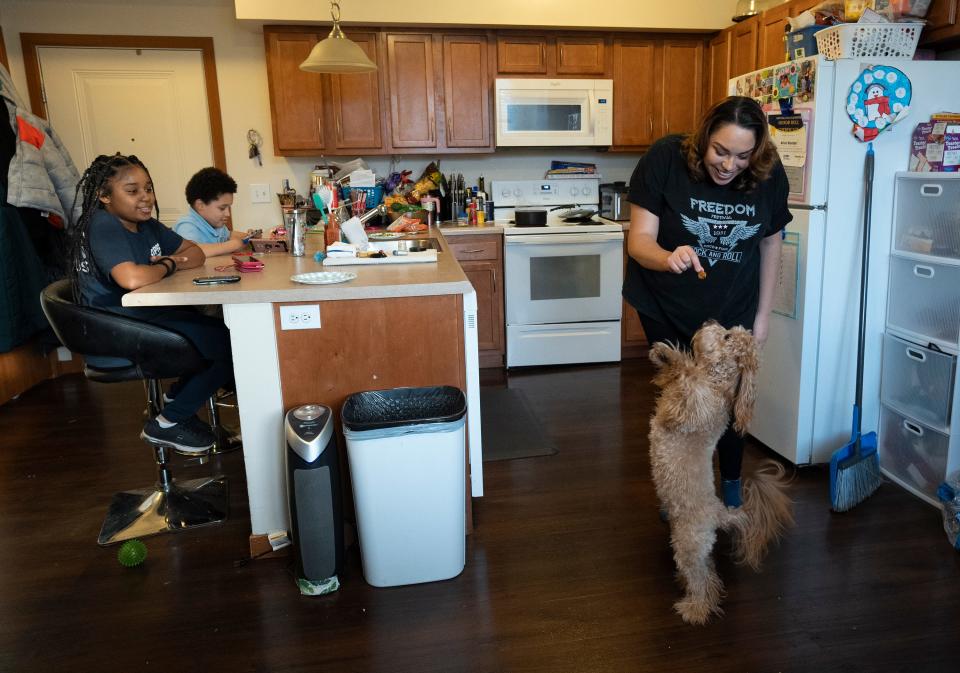Over 163,000 Franklin County food stamp recipients will lose $10M in COVID benefits in March

For Jasmine Wooten, the COVID-19 pandemic exacerbated an already grim situation.
The 33-year-old social worker and mother of two, who lives on the Near East Side, was already getting food benefits when the pandemic hit. Nearly three years later, it's become even more difficult to put food on the table, due in part to inflation, misperceptions about those who get benefits and lack of empathy from people in power, she said.
"It's absolutely worse because the price increases in groceries have shot up astronomically," Wooten said. "What used to just get us by … even with supplementation, is not enough."
Wooten's financial situation will take yet another hit in a few weeks when she and more than 163,000 other Franklin County residents lose a collective $10 million in food benefits in March, when a needed supplemental boost in food benefits due to the COVID-19 pandemic comes to an end.

More:Woes continue for Greater Columbus food-assistance programs struggling to meet need
More:Food pantries in Ohio, Greater Columbus struggle to feed hungry amid surging inflation
Franklin County Job & Family Services got word earlier this month from the Ohio Department of Jobs and Family Services that the extra monthly payments, part of the Supplemental Nutrition Assistance Program (SNAP), would cease at the end of February, agency spokesperson Bart Logan told The Dispatch.
"We anticipated this coming, but everything that had been communicated to us … was that these (benefits) were tied to the federal public health emergency" and wouldn't end until April at the earliest, Logan said.
But a federal omnibus bill recently stripped the authority from the U.S. Department of Agriculture to continue the benefits.
Now, county officials are scrambling to spread the word to recipients, including those whose first language is not English, about the change so they're not blindsided when they stop receiving separate checks.
At the start of the pandemic, the COVID relief package added extra funding to SNAP benefits, giving recipients the maximum amount allowable, based on the size of their household. Under the upcoming change, allocations will go back to being based on income level.
In Franklin County, a family of four at the highest threshold would go from receiving $939 a month to $753, while the payment to an individual receiving $281 a month would be reduced to $23, Logan said.
For Amber Hawthorne, 32, of the South Side, who is on a fixed income from veteran's disability benefits and doesn't work, the emergency benefits allowed her to stock up on extra food each month, including meat and one of her children's favorite foods: eggs.
But with the extra benefits soon ending, Hawthorne said she'll likely have to rely more on Lutheran Social Services Food Pantries. Until then, she'll stock up on as many nonperishable items as she can and start creating a budget plan.
"I feel like I'm going to be one of the people going to the pantry more often than not," she said.
Central Ohio food banks, other agencies working to soften the blow
Franklin County Job & Family Services has already reached out to the Mid-Ohio Food Collective and plans to organize virtual meetings to provide recipients with more information about where to go for supplemental food, better ways to make their regular benefits last longer and creating an informational toolkit on the agency's website.
Meanwhile, the Columbus-based Ohio Association of Foodbanks is buying as much food as it can for its network of 12 foodbanks and 3,600 member charities across the state, Executive Director Lisa Hamler-Fugitt said.
"It couldn't come at a worse time, quite frankly, because we aren't seeing a return to so-called normal," Hamler-Fugitt said. "SNAP is the first line of defense to hunger in our nation. … We're feeding more people now than we were at the height of the pandemic."
With fewer benefits, it's not just SNAP recipients who will be affected, she said. Grocery stores in high-need areas that are already operating on small margins also will suffer; food banks and soup kitchens will see an increase in traffic; and more people will be going to school and work hungry.
More:Looking to stretch your food budget? These tips and recipes won't strain your wallet
More:700,000 low-income Ohio households could see big cuts to food stamps program in July
The Mid-Ohio Food Collective has already seen an increase in demand for its services across 20 counties. In 2022, there was a 33% increase in the number of visits to food pantries and a "stunning" 45% increase in the number of first-time customers to nearly 200,000 in the region, said Mike Hochron, senior vice president of communications.
As an expanded child tax credit went away and COVID relief payments dwindled, more families started having to choose between putting food on the table and paying the rent.
"Our expectation is that we're going to see an increase in families that are food insecure that are having to make different choices about where to put resources, and we can only hope that those families have the information they need," Hochron said. "Providing information is a good starting point."
The agency also works with individuals and families to address the underlying issues that often intersect with hunger, from housing and education to transportation and legal services.
"By the time a family's food budget is strained … we know there are a lot of other parts of their life that are under stress," Hochron said. "We try to serve the whole person and respond to the individual person. Food insecurity isn't about food; it's about income and resources."
How can the community help address hunger?
While the change will go into effect March 1, there's plenty people can do to help address hunger in Columbus and across Central Ohio, whether it's in the form of money, time or resources, Hochron said, noting every dollar donated can fund $5.22 worth of groceries.
Hochron also encouraged those who need help to reach out.
"We know there's going to be a lot of people (in need), and some folks are afraid to ask for help, thinking somebody else needs it more," he said.
Advocates also are calling on elected leaders to help address the issue in a variety of ways, from providing more funding through the federal farm bill to educating state legislators about the costs of allowing hunger to skyrocket.
Wooten said more effective programs aimed at helping people transition away from benefits also would make a huge difference.
"I think that people in power that have a seat at the table to make change and affect policies really should live up to their missions and the people that they're serving instead of stigmatizing and stereotyping them," Wooten said.
"We could take a million and a half financial literacy programs, but when you have 5 cents in your bank account, you can't budget your way out of poverty," she said. "Why don't we incentivize women and let them transition … without ripping away the resources immediately, so they can get ahead?"

Other ways to address food insecurity include offering free universal breakfast and lunch programs in schools, as well as supplemental state benefits, such as $75 in monthly payments to older adults and people with disabilities who already get federal SNAP benefits, Hamler-Fugitt said.
But for now, officials are encouraging SNAP recipients to start thinking about how they will prepare, including stocking up on food now, thinking of ways to stretch their benefits a bit further, and calling their member in Congress. SNAP recipients should also make sure they know how much they have in their accounts by going to benefitsohio.gov or calling 844-640-6446, Hamler-Fugitt said.
"The time to start planning is now," she said.
nshuda@dispatch.com
@NathanielShuda
This article originally appeared on The Columbus Dispatch: Franklin County will lose $163,000 in food stamp benefits in March

